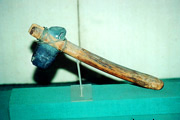| Legole.Com Discover china. Explore the beauty and wonder of the land, people, and culture of China. |
 |
|
|
 |
| |
 Around 10,000 years ago humans entered the Neolithic Age, the last phase of the Stone Age, which was marked by an improvement in implements, domestication of animals, the development of agriculture, and the manufacturing of pottery and textiles. Around 10,000 years ago humans entered the Neolithic Age, the last phase of the Stone Age, which was marked by an improvement in implements, domestication of animals, the development of agriculture, and the manufacturing of pottery and textiles.
The use of stone tools became widespread. The tools were polished and honed, sized and neatly shaped for a multitude of uses. The making of farm implements led to early man trading their nomadic hunting and gathering lifestyle for a more settled one of farming. Many retreated from mountain areas and migrated to the plains, settling close to a water source. They built houses, lived in a community, and worked together for a common goal of production. While some grew rice along the banks of the Yangtze River, others grew millet along the middle reach of the Yellow River.
Craftsmen became more advanced in the manufacturing of pottery, jadeware and textiles. The big step forward in progress was a major transition between humans being entirely subject to nature's way and --- the beginning of civilization where humans began controlling nature to make their lives easier, while advancing civilization.
Two major aspects of Neolithic Age social structure, included monogamy replacing polygamy and other forms of clan mating,, and people organizing from small groups to a large tribal clan community. The best example of this can be found on the site of Jiangzhai at Lintong county, Shaanxi province.
The Neolithic Age ended around 5000 BC in Asia while it flourished in Mayan Culture from 4,500 BC to 2,500 BC.
|
|
|
 |
|
